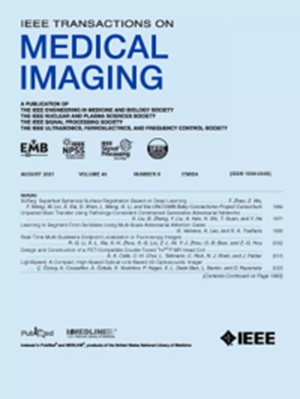基于影响点引导的渐进式教师无源主动域自适应医学图像分割。
IF 9.8
1区 医学
Q1 COMPUTER SCIENCE, INTERDISCIPLINARY APPLICATIONS
引用次数: 0
摘要
医学图像分割中的领域自适应使预先训练好的模型能够泛化到新的目标领域。考虑到标注数据有限和隐私限制,无源主动域自适应(SFADA)方法在不访问源样本的情况下选择少量目标样本进行标记,提供了很有前途的解决方案。然而,在完全无源的情况下,现有的工作并没有充分探索如何以类平衡的方式选择这些目标样本,以及如何使用标记和未标记的样本进行鲁棒模型自适应。在本研究中,我们发现具有类似源语义但预测差异明显的边界样本有利于SFADA。我们将这些样本定义为最具影响力的点,并提出了一个使用影响力点学习来探索它们的切片框架。具体来说,我们检测类源样本以保留特定于源的知识。针对每个目标样本,引入基于局部密度的自适应k近邻算法,构建类源样本的邻域进行知识转移。然后,我们为这些社区提出了一个阶级平衡的Kullback-Leibler散度,计算它以获得一个有影响力的分数排名。排名最高的目标样本(被认为是影响点)的不同子集被手动注释。此外,我们还设计了一种渐进式教师模型来促进SFADA对医学图像的分割。该模型在影响点的引导下,独立生成并利用伪标签来减少误差积累。为了进一步抑制噪声,课程学习被纳入模型,以逐步利用伪标签的可靠监督信号。多个基准测试的实验表明,我们的方法优于最先进的方法,即使只有2.5%的标签预算。本文章由计算机程序翻译,如有差异,请以英文原文为准。
Source-Free Active Domain Adaptation via Influential-Points-Guided Progressive Teacher for Medical Image Segmentation.
Domain adaptation in medical image segmentation enables pre-trained models to generalize to new target domains. Given limited annotated data and privacy constraints, Source-Free Active Domain Adaptation (SFADA) methods provide promising solutions by selecting a few target samples for labeling without accessing source samples. However, in a fully source-free setting, existing works have not fully explored how to select these target samples in a class-balanced manner and how to conduct robust model adaptation using both labeled and unlabeled samples. In this study, we discover that boundary samples with source-like semantics but sharp predictive discrepancies are beneficial for SFADA. We define these samples as the most influential points and propose a slice-wise framework using influential points learning to explore them. Specifically, we detect source-like samples to retain source-specific knowledge. For each target sample, an adaptive K-nearest neighbor algorithm based on local density is introduced to construct neighborhoods of source-like samples for knowledge transfer. We then propose a class-balanced Kullback-Leibler divergence for these neighborhoods, calculating it to obtain an influential score ranking. A diverse subset of the highest-ranked target samples (considered influential points) is manually annotated. Furthermore, we design a progressive teacher model to facilitate SFADA for medical image segmentation. Guided by influential points, this model independently generates and utilizes pseudo-labels to mitigate error accumulation. To further suppress noise, curriculum learning is incorporated into the model to progressively leverage reliable supervision signals from pseudo-labels. Experiments on multiple benchmarks demonstrate that our method outperforms state-of-the-art methods even with only 2.5% of the labeling budget.
求助全文
通过发布文献求助,成功后即可免费获取论文全文。
去求助
来源期刊

IEEE Transactions on Medical Imaging
医学-成像科学与照相技术
CiteScore
21.80
自引率
5.70%
发文量
637
审稿时长
5.6 months
期刊介绍:
The IEEE Transactions on Medical Imaging (T-MI) is a journal that welcomes the submission of manuscripts focusing on various aspects of medical imaging. The journal encourages the exploration of body structure, morphology, and function through different imaging techniques, including ultrasound, X-rays, magnetic resonance, radionuclides, microwaves, and optical methods. It also promotes contributions related to cell and molecular imaging, as well as all forms of microscopy.
T-MI publishes original research papers that cover a wide range of topics, including but not limited to novel acquisition techniques, medical image processing and analysis, visualization and performance, pattern recognition, machine learning, and other related methods. The journal particularly encourages highly technical studies that offer new perspectives. By emphasizing the unification of medicine, biology, and imaging, T-MI seeks to bridge the gap between instrumentation, hardware, software, mathematics, physics, biology, and medicine by introducing new analysis methods.
While the journal welcomes strong application papers that describe novel methods, it directs papers that focus solely on important applications using medically adopted or well-established methods without significant innovation in methodology to other journals. T-MI is indexed in Pubmed® and Medline®, which are products of the United States National Library of Medicine.
 求助内容:
求助内容: 应助结果提醒方式:
应助结果提醒方式:


